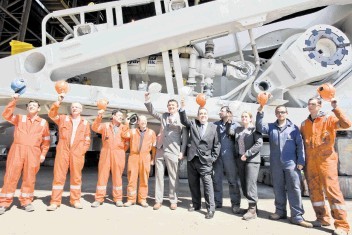
All-Energy is a landmark in the year for everyone in renewables; a chance to meet up with the people that make the industry tick; and a chance to reflect on the progress of this still very ‘green’ segment of the energy world.
This year there have been so many positives it is hard to know where to start a summary.
In finance, the Scottish Government finally got its hands on half the Fossil Fuel Levy, with plans now being developed to maximise the impact of the £100million investment.
The UK Government has announced that the Green Investment Bank is to be headquartered in Edinburgh.
And the Catapult Centre, which will bring industry and academia together to provide a singular focus on the challenge of driving down the costs of offshore wind and marine energy, will be based at Strathclyde University in Glasgow.
Government investments have been more than matched by the private sector’s own plans for growth.
Samsung has committed to establishing assembly of its next-generation offshore turbine in Methil; Gamesa will invest in Leith; and Global Energy is finally able to progress its plans for Nigg.
Scottish Renewables published the first comprehensive study of employment in the sector, with over 11,000 jobs now supported directly by renewables in Scotland.
Perhaps the most important breakthrough of all was Ofgem’s ‘thumbs-up’ to the necessary upgrades to Scotland’s grid network and connections with the rest of the UK.
The regulator has effectively signed off the investment in ‘wires’ required to hit the Scottish Government’s 100% renewable electricity target.
And if there was any doubt about the progress we have made in recent years, DECC (Department of Energy and Climate Change) figures show that renewable electricity output in Scotland in 2011 was equal to 35% of all demand – comfortably surpassing the 31% target.
All of this confirms what we have been saying for a considerable time: that renewables are now a major part of our energy mix and an increasingly significant part of the economy.
However, Electricity Market Reform and other changes threaten to undermine confidence and already appear to be slowing down investment.
The energy industry will finally see some detail on the proposals with the publication of the Energy Bill later this month, but two years on from the beginning of the process, the sector is still unclear about how the reforms will work, nervous about the institutions that will be required to support the new support mechanism, and sceptical about the timescales for their implementation.
As one renewables industry figure describe the situation: “Government has asked us to go on a journey but can’t tell us exactly where we are going, or how and when we are going to get there.”
Little wonder that many of Scottish Renewables’ members are so worried about the increasingly complexity of the reforms believe that they cannot be implemented and are lobbying us hard to make sure that the Government leaves other options open in case it proves impossible to establish the pillars necessary to support the Contract for Difference.
There is little disagreement with the reform’s core aim of providing the industry with greater certainty on future revenues in exchange for lower levels of return on investment, but at this moment in time our members are not convinced that this will be achieved.
Until government can provide that assurance, businesses will continue to request that other options are left on the table.
This uncertainty could not come at a worse time for offshore wind developers and their supply chain, with huge amounts of capital being invested in the early stages of Round Three offshore wind projects, all of which look like straddling the last stages of the RO (Renewables Obligation) and the early days of Contracts for Difference.
But this is not just an abstract argument about renewables support post-2017. Uncertainty about the reform’s impact on the future wholesale market means that generators are finding it ever harder to find a buyer for their output today.
Conversations with our members suggest that there are fewer and fewer companies willing to enter into Power Purchase Agreements, and those that are willing are offering shorter and shorter contracts, and offering decreasing prices for power.
This means that smaller developers and community projects are finding it ever harder to convince banks to lend and are having to put up increasing amounts of equity to take their projects forward.
The smallest projects face even greater uncertainty with the review of the Feed-in Tariff, and the postponement of the Renewable Heat Incentive means the earliest movers in this area are still waiting for the market to develop.
So despite the challenges over planning, the polarised debate on onshore wind and worries over skills, it is the uncertainty over the future market for renewable heat and power that trumps all other threats to our ambitions.
It’s been a long time coming, but let’s hope that the Draft Energy Bill finally starts to chart a way through the uncertainty and to our shared ambitions for a stable and attractive investment climate that will ensure the development of the industry in a way that does not place unfair or unsustainable burdens on consumers.
The announcements above mean we all know exactly what is at stake: jobs, investment, economic competitiveness and progress towards our CO2 and renewables targets.
Niall Stuart is CEO of the trade association Scottish Renewables
Recommended for you
